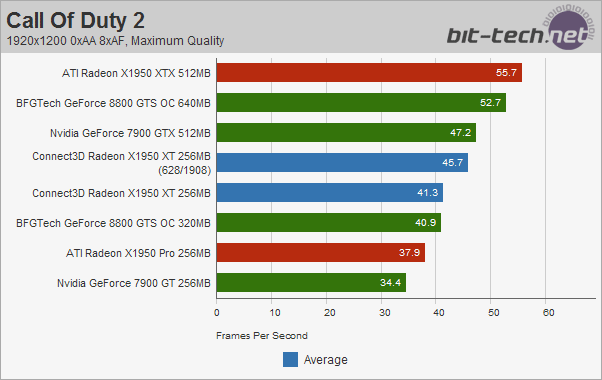
Overclocking:
We overclocked Connect3D’s Radeon X1950 XT 256MB using a combination of ATiTool version 0.26 and ATI’s Overdrive utility, which is built into Catalyst Control Center. Our overclocking experiments should be sufficient to give you an idea how far a typical Radeon X1950 XT 256MB will overclock, but as is always the case, your own overclocking mileage may vary and we cannot guarantee that our Radeon X1950 XT 256MB isn’t a particularly good or bad overclocker.The stock clocks for the Connect3D X1950 XT 256MB are 621MHz core and 900MHz (1800MHz effective) on the memory. After overclocking, we managed to get the card running perfectly stable at 628MHz core and 1908MHz memory. Any higher and we encountered either crashing if the core was increased to 635MHz (the next clock speed 'step') and if we increased the memory any higher, we were greeted with artifacting and tearing.
We re-ran our high-resolution Call Of Duty 2 benchmarks to give you an idea of how these clock speed increases affect the card's performance.

Final Thoughts...
Connect3D’s Radeon X1950 XT 256MB is a fairly solid performer if you know the card’s limitations before you begin considering it. If you’re looking to game at 1920x1200, you’re better off spending a bit more and looking at Nvidia’s GeForce 8800 GTS 640MB, as it will give you consistently good performance at this resolution in current games. If you are firmly in ATI’s camp, your next step up the ladder is the Radeon X1950 XTX, but not only is it based on older technology; it’s also slower and costs about the same as a GTS 640MB.We can’t really predict what will happen in the future, but it’s possible that the GeForce 8800 GTS 640MB will be able to handle next-generation DirectX 10 games at 1920x1200 to some extent and it’s definitely more likely than if you’re considering saving a bit of cash by getting the 320MB 8800 GTS. Given that Nvidia’s GeForce 8800 GTS 320MB (and in particular BFGTech’s OC Edition that we’ve tested here) start at around £195 (inc VAT), Connect3D’s Radeon X1950 XT 256MB is in a different bracket at just over £140. Its performance characteristics based on our benchmarks would also prove that this is the case, too.
At the moment, Nvidia doesn’t really have anything in the same price bracket as ATI’s Radeon X1950 XT 256MB – the closest thing we’ve found is the GeForce 7950 GT, which retails for around £160 (inc VAT). Both GeForce 7900 GTX and GeForce 7900 GT are priced out of the market, at around £185 (inc VAT), so it’s really left down to GeForce 7950 GT. While we haven’t tested one here, the card’s performance is right in between GeForce 7900 GTX and GeForce 7900 GT, making it slower than Connect3D’s card at the resolutions that really matter for this card.
The Radeon X1950 XT 256MB is ideally suited to deliver great performance at 1280x1024 with maximum details and high levels of anti-aliasing. In addition, it’s also capable of pushing out the frames frequently enough to enjoy games at 1600x1200 too. However, both the short and longer term benefits you’ll get from GeForce 8800 GTS 320MB at 1600x1200 make it a better contender for running games at that resolution and, in the long term, it’s probably worth investing that extra £50 into if you can afford it.
At 1280x1024, Connect3D’s card is probably the best bang for buck at the moment if you’re looking for something to last you until mid-range DirectX 10 hardware from either ATI or Nvidia shows up in the next few months. However, if you’re concerned about noise, you’re going to have to spend a bit more on an aftermarket cooling solution.





MSI MPG Velox 100R Chassis Review
October 14 2021 | 15:04








Want to comment? Please log in.